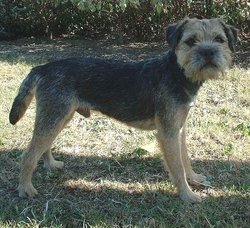
|
Dog breeds of the world, Border Terrier |
| Border Terrier | ||
|---|---|---|

|
||
| Alternative names | ||
| Country of origin | ||
| United Kingdom | ||
| Common nicknames | ||
| Classification and breed standards | ||
| FCI: | Group 3 Section 1 #10 | |
| AKC: | Terrier | |
| ANKC: | Group 2 (Terriers) | |
| CKC: | Group 4 - Terriers | |
| KC (UK): | Terrier | |
| NZKC: | Terrier | |
| UKC: | Terriers | |
| Not recognized by any major kennel club | ||
| This breed of Dog is extinct | ||
| Notes | ||
A Border Terrier is a small, rough-coated breed of Dog in the terrier family.
The Border Terrier has a double coat consiting of a soft undercoat and harsh, wiry outer coat. Colours include grizzle and tan ( a sort of salt and pepper look), blue and tan (sometimes looks almost black), red grizzle, and, less commonly, wheaten. The coat needs to be stripped by hand (not clipped) regularly, as the top coat becomes long and shaggy and eventually dies. Borders being shown generally have a short coat that has been stripped and is starting to grow back in.
Border Terriers are friendly and playful, and can make good family pets as they are sometimes good with children. They are best kept by people who have had Dogs before and know how to maintain human social dominance over them. They are highly energetic Dogs, and so unless a lot of time can be devoted to them, they are generally best kept with other Dogs of similar temperament. Ideal companions would be other Border Terriers, Collies, and most Spaniels.
Border Terriers are relatively easily trained, although they can develop a cat-like independence and, when kept as part of a group of Dogs, can have confusion recognising that each Dog has a different name (they occasionally respond to them all). Some members of the breed make a highly effective alternative to a doorbell, due to their sharp hearing and the distinctive frenzied barking that results when they hear someone approaching the door. They are best kept in pairs or small groups, or with Dogs of other breeds. Their dominant personalities can be used to the advantage of the owner if larger Dogs are also kept as, like all terriers, they will generally occupy a high position in the 'pack', subordinate to the owner. This is especially true if a Border Terrier is an adult and the larger Dog a puppy when introduced. However, if a large Dog comes into the family, although it is already an adult one, the Border Terrier starts to "test" his new companion and, if there's no objection from the side of the larger Dog, maintains his leadership.
Border Terriers are generally unsuitable for homes where there are rabbits, cats (except Maine Coons), smaller breeds of Dogs, or other similar pets, as they will attack and kill all animals smaller than themselves; they were bred for this purpose. Exceptions to this are where the Terrier was introduced to the other animal as a puppy. Despite this instinct, they are generally amicable with other Dogs, and often develop strong friendships with Dogs they meet frequently. Nevertheless, in case they don't like another Dog, they don't hesitate to start a fight and, as it is the case with most terriers, it's not easy to stop them. One has to train the Border Terrier carefully from the beginning so that he learns a correct social behaviour with other Dogs (especially with Dogs that are of bigger size!).
Any toy given to a Border Terrier needs to be virtually indestructible. Solid, tough rubber toys such as rubber rings are suitable; however, certain individuals might have a fascination for other objects found in their environment, some of which the owner might not have wanted to be Dog toys.
Border Terriers are generally hardy and long-lived Dogs with few health problems; however, they also have a very high resistance to pain and so a Border Terrier, when it is unwell, will very often appear perfectly healthy. Consequently, any sign of illness should be taken very seriously. Due to their low percentage of body fat, Border Terriers are very sensitive to anesthetics and therefore care should be taken in selecting a veterinarian that is aware of this and is cautious in administering anesthesia.
In addition, due to their instinct to kill and consume smaller animals, Border Terriers often destroy (rather than play with) their toys?especially toys that are insufficiently robust?and often eat such toys in the process. A Border Terrier can remove the squeak from a squeaky toy within 30 seconds, and reduce such toys to fragments within a matter of minutes. This tendency can cause the appearance of illness as a result of the subsequent indigestion; typical symptoms include lethargy, unwillingness to play, a generally 'unhappy' appearance, lack of reaction to affection, and inability or unwillingness to sleep. These symptoms are generally very noticeable; however, they are also present just prior to Border Terrier bitches being on heat. Food-grade liquid paraffin is often an effective solution to digestive problems caused by the consumption of Dog toys.
Border Terriers occasionally have genetic health problems. Some of these include:
Reliable breeders check all breeding stock for as many of these as possible before breeding.
The breed was developed for fox hunting in the area around the border of England and Scotland.
Dog breeds of the world, Border terrier